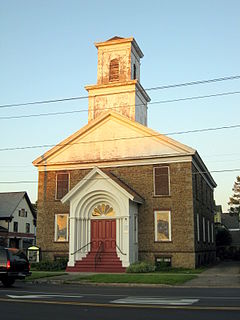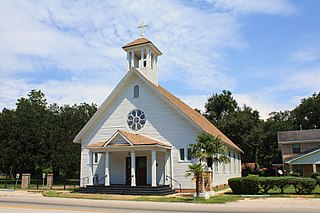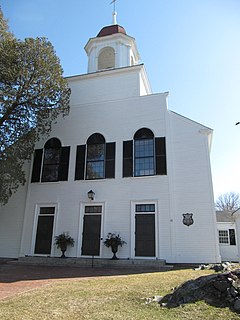
This is intended to be a complete list of properties and districts listed on the National Register of Historic Places in Orleans County, New York. The locations of National Register properties and districts may be seen in a map by clicking on "Map of all coordinates". Two listings, the New York State Barge Canal and the Cobblestone Historic District, are further designated a National Historic Landmark.

Chatham–Arch is a neighborhood located immediately east of Downtown Indianapolis, Indiana, United States. This neighborhood is one of the oldest in Indianapolis, dating back to the mid 19th century. Chatham–Arch contains many of Indianapolis's historic homes.

St. David's Episcopal Church is a historic church in downtown Austin, Texas, United States. Its main church building was constructed in 1854–1855, making it one of the oldest standing buildings in the city. The first Episcopal church in Austin was briefly organized in 1848, nine years after Austin was founded. In 1851 the parish was reorganized, and work on the church building began two years later. The church is located at 304 E. 7th Street. It was added to the National Register of Historic Places in 1978.

The First Universalist Church is a historic church at 250 Washington Street in Providence, Rhode Island.

The First Religious Society Church and Parish Hall is a historic church building at 26 Pleasant Street in Newburyport, Massachusetts. Originally a Reformed congregation, the congregation is currently affiliated with the Unitarian Universalist denomination. The current Minister is Reverend Rebecca M. Bryan. The church's steeple is currently the tallest point in downtown Newburyport, Massachusetts.

The First Parish Unitarian Church, now the First Parish Unitarian Universalist Church of Medfield, is a historic church on North Street in Medfield, Massachusetts. The white clapboarded church was built in 1789, as the third for a congregation established c. 1652. In 1839 it was rotated on its site ninety degrees. It lost its steeple in the New England Hurricane of 1938. The steeple was replaced in 1988, and the building's many layers of paint were stripped off in 2007.

Guaranty Building is a high-rise Beaux Arts office building located at 6331 Hollywood Boulevard in Hollywood, Los Angeles, California. It was built in 1923 and was designed by John C. Austin. It was added to the National Register of Historic Places on September 4, 1979. The building is currently owned by the Church of Scientology.

The Unitarian Universalist Church of Cortland, New York, also known as "The Old Cobblestone Church," is an historic cobblestone church building located at 3 Church Street in Cortland, New York, United States. Built in 1837, the building was established as a Universalist church. Since 1961, the congregation has been a member of the Unitarian Universalist Association due to a denominational merger. The Unitarian Universalist Church of Cortland was listed on the National Register of Historic Places in 1993.

First Unitarian Universalist Church of Niagara is a historic church located at Niagara Falls in Niagara County, New York. It was constructed in 1921 in a Classical Revival style. The steel and concrete church is faced with rough, uncut limestone from the bedrock excavated for the building's foundation.

Saint Francis Xavier Roman Catholic Church, also known as St. Francis Xavier Church, is a historic Roman Catholic church building in the Toulminville neighborhood of Mobile, Alabama, United States. It serves as the parish church for St. Francis Xavier Parish in the Roman Catholic Archdiocese of Mobile. St. Francis Xavier Parish was established in 1868. The vernacular style building was completed in 1916, replacing a previous structure destroyed in a hurricane. It was placed on the National Register of Historic Places on July 3, 1991, as part of the Historic Roman Catholic Properties in Mobile Multiple Property Submission.

Cavendish Universalist Church is a historic church building on Vermont Route 131 in Cavendish, Vermont. It was built in 1844 by Scottish immigrant stonemasons, using a "snecked" ashlar stone finish that is rare in the state outside the immediate area. The building was added to the National Register of Historic Places in 1973.

The First Universalist Church of Cedar Rapids, also called the Peoples Church Unitarian Universalist is listed on the National Register of Historic Places. Built in 1875, it served the Unitarian Universalist community of Cedar Rapids, Iowa, USA, for more than 135 years. Because of the high cost of upkeep and diminishing membership, the congregation voted to sell the building and grounds in May 2010. It was demolished in October 2011.

First Universalist Church of Sharpsville is a historic Universalist church located at 131 N. Mercer Avenue in Sharpsville, Mercer County, Pennsylvania, United States. The church was built between 1882 and 1884, and is a richly decorated brick and stone church building in a High Victorian Gothic style. It measures 52 feet by 42 feet and the interior takes the Akron plan. The property includes the parsonage; a two-story Queen Anne style dwelling built in 1888.

The Universalist Church is a historic building located in Mitchellville, Iowa, United States. The congregation was organized in 1868 with a membership of thirty-five people. The first officers were: Thomas Mitchell, Moderator; Barlard Slate, Clerk; and Tillie Mitchell, Treasurer. The deacons were W.S. Jones, A. Rothrock and Pauline Weeks. Pastors included: W.W. King, T.C. Eaton, J.R. Sage, A. Vedder and F.W. Gillette. The church building was erected at a cost of $2,000.

Sheldahl First Norwegian Evangelical Lutheran Church is a historic building located in Sheldahl, Iowa, United States. The community was platted by Osmund Sheldahl and J.S. Polk. Sheldahl was a lay Lutheran minister who settled in Illinois in 1845. He and three others came to this area in 1854 in search of cheap available land. The following year, 21 families that had organized themselves as the "Palestine Congregation" relocated to Story County. Sheldahl became a large land owner and the regular pastor for Palestine Lutheran Church in 1860. He built a house in town in 1877 and he and his two sons built this church building in 1883. Osmund Sheldahl served the congregation as an unpaid pastor for 13 years. His will stipulated that the church building be made available to any Christian denomination that emphasized Bible teaching. It remained in regular use until 1936.

Rock Spring Presbyterian Church is a historic Presbyterian church at 1824 Piedmont Avenue NE in Atlanta, Georgia. Designed by Atlanta architect Charles H. Hopson, it was built in 1923 and additions were made to the rear in 1952 and in 1963. It is cross-shaped in plan and Tudor Revival in style.

The New Castle Congregational Church is a congregation of the United Church of Christ, located at 65 Main Street in New Castle, New Hampshire. Its church, the only ecclesiastical building in the small community, was built in 1828 by a local master builder, based on the architectural patterns published by Asher Benjamin, and also based in part on the St. John's Church in nearby Portsmouth. It has undergone little alteration since its construction.

All Souls Church, also known as All Souls Unitarian Universalist Church of Braintree, is a church on the National Register of Historic Places, it is located at 196 Elm Street in Braintree, Massachusetts. The building is a large fieldstone structure, in a cruciform plan with a square tower that has a crenellated top. The gable ends are decorated with bargeboard, and the entrance is set under a gabled entry porch below a large window with Gothic tracery. The church was designed by Boston architect Edwin Lewis and built in 1905 for a congregation organized in 1900; it is Braintree's first stone church building. Land for the building was donated by George O. Wales, a leading force in uniting Braintree's Unitarian and Universalist congregations.

St. Philip Neri Parish Historic District is a historic Roman Catholic church complex and national historic district located at Indianapolis, Indiana. The district encompasses five contributing buildings: the church, rectory, former convent and school, school, and boiler house / garage. The church was built in 1909, and is a Romanesque Revival brick church with limestone trim. It features two- and three-story crenellated corner towers, a rose window with flanking round arched windows, and Doric order columns flanking the main entrance.

Holy Rosary–Danish Church Historic District, also known as Fletcher Place II, is a national historic district located at Indianapolis, Indiana. The district encompasses 183 contributing buildings in a predominantly residential section located in the central business district of Indianapolis. It was developed between about 1875 and 1930, and include representative examples of Italianate, Gothic Revival, Tudor Revival, and Renaissance Revival style architecture. Located in the district is the separately listed Horace Mann Public School No. 13. Other notable buildings include the John Kring House, Trinity Danish Evangelical Lutheran Church (1872), John Wands House (1857), Henry Homburg House, Samuel Keely House, Maria Wuensch Cottage, and Holy Rosary Catholic Church (1911-1925).






















